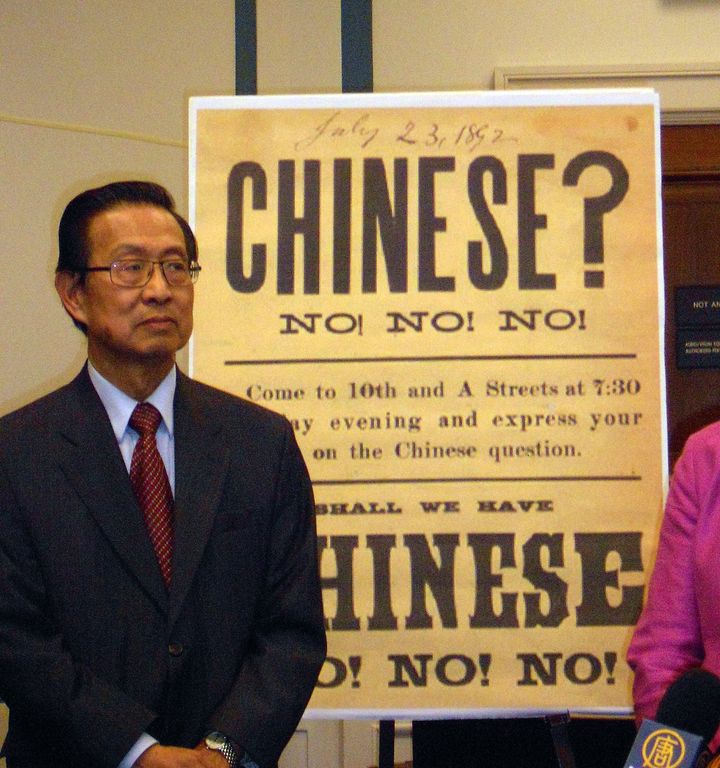
An 1882 law that’s become relevant to today’s immigration debates is a blueprint for racist policies that should remain in the past, experts say.
Saturday marks 135 years since passage of the Chinese Exclusion Act, which historians say has turned out to be an original model for today’s race-based bans, deportation policies and immigrant wages. The law, which prohibited all immigration to the U.S. by Chinese laborers, was one of the first major U.S. policies that banned a group of people on the basis on race.
“The Chinese Exclusion Act gave way to America as the ‘gate-keeping nation,’” Beth Lew-Williams, an assistant professor at Princeton specializing in Asian-American history, told HuffPost in an interview in December. “What stayed in place was system of immigration deportation and removal we have today. And the idea that border control should involve deportation.”
“The Chinese Exclusion Act gave way to America as the ‘gate-keeping nation.'”
Chinese people already living in the U.S. as of 1882 were forced to face issues such as ethnic registries, deportation and hate crimes.
But the new wave of Chinese coming to America amid the Gold Rush ― who would eventually help construct the transcontinental railroad at lower wages than whites ― became among the nation’s first undocumented immigrants.
The ban was quasi-repealed on Dec. 17, 1943, allowing 105 Chinese visas per year, an act that many perceived as a way to maintain U.S.-China relationships against Japan during World War II.
In 1965, the Immigration and Nationality Act fully reversed exclusionary practices, which some historians say was meant to prop up Asians as the “model minority” amid the Civil Rights movement.
Despite repeals, experts point out how discriminatory rhetoric can yield dehumanizing treatment ― even as policies come and go.
“After the Exclusion Act was passed, it emboldened people who wanted to get rid of the Chinese. The public was doing vigilante activities.”
In December, HuffPost spoke with renowned Chinese immigration expert, Peter Kwong, a former Asian-American studies professor at Hunter College, before he passed away in March.
Kwong, who was also the author of several books on Chinese-Americans, also drew parallels to the current administration, explaining how discriminatory laws can incite more hate.
“After the Exclusion Act was passed, it emboldened people who wanted to get rid of the Chinese. The public was doing vigilante activities.”
“Lawmakers were trying to appease the public back then. There were two major massacres in Wyoming and Idaho. They tried to pass more laws and terrorize Chinese people using violence,” he said.
The context for how Chinese were being treated in America at the time was based on ethnocentrism and a desire to maintain power, Lew-Williams said.
“The Chinese were originally seen as racially unassimilable. They could not become Americanized,” she said. “They were simultaneously racially inferior, backwards, savage heathen ― and in some dangerous ways ― superior.”
She said that Americans felt threatened for two reasons – because of their desire to maintain “racial purity” and because of the fact that Chinese workers could work faster than Americans. But she said this work ethic might have been born out of necessity and then perceived as innate.
Lew-Williams pointed to a discriminatory labor system in place after Chinese people came here for the Gold Rush and found work in fields including lumber, agriculture and railroad construction. She points out that people saw the Chinese as more industrious, but that could be due in part to job demands enacted by white Americans.
“It was a race-based dual wage system at the time,” she said. “Chinese were paid less, given the worst strenuous jobs. People against the Chinese saw this as revealing of their innate nature. That Chinese were fundamentally “cheap” labor and designed to do this back-breaking labor.”
“Chinese were paid less, given the worst strenuous jobs. People against the Chinese saw this as revealing of their innate nature. That Chinese were fundamentally 'cheap.'”
Kwong pointed out how these stereotypes discount diversity among Asians.
“Because some Chinese people succeeded doesn’t mean working class Chinese have the same capability and upward mobility. It’s a class issue.”
He said that once more wealthy Chinese individuals immigrated to the U.S., the perception of Asian-Americans as model minorities was cemented. His hope was that people don’t lose sight of the struggles of the original Chinese-Americans that continue to persist.

